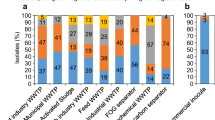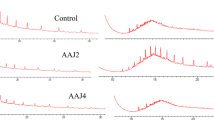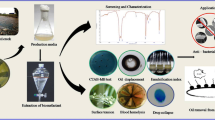Abstract
Oily sludge generated by the petroleum industry is not only an environmental hazard, but since it contains crude oil too, it is a valuable resource as well. This study demonstrates a methodology for the valorization of the oily sludge that allows the recovery of oil fractions by the action of microbes producing surface-active metabolites. Two bacterial isolates were used in the study that were producing different biosurfactants, identified via FTIR analysis as well as through genomic mapping of the biosurfactant pathways using RAST, ANTISMASH 7.0, STRING databases. Serratia spp. AKBS12, produced a mono-rhamnolipid, while Acinetobacter spp. AKBS16, produced emulsan. Although recovery efficiency of both biosurfactants was similar, the recovery profile with respect to the class of hydrocarbons differed. The rhamnolipid produced by Serratia spp. AKBS12 extracted mono-chained paraffins and linear alkanes, while emulsan, produced by Acinetobacter spp. AKBS16 could extract heavier paraffins. The extraction procedure is simple and involves mixing the biosurfactant with oily sludge at a temperature of 30 °C with an incubation of 9 days. Sulphuric acid precipitation releases the oil trapped in the oily sludge. The study is the first step in developing user-friendly, innovative technologies that can be linked to the concept of a circular economy.
















Similar content being viewed by others

Data availability
The datasets generated during and/or analyzed during the current study are available from the corresponding author on reasonable request.
References
Abdel-Mawgoud AM, Lépine F, Déziel E (2010) Rhamnolipids: diversity of structures, microbial origins and roles. Appl Microbiol Biotechnol 86:1323–1336. https://doi.org/10.1007/S00253-010-2498-2/TABLES/2
Adnan M, Siddiqui AJ, Noumi E et al (2022) Integrating network pharmacology approaches to decipher the multi-target pharmacological mechanism of microbial biosurfactants as novel green antimicrobials against listeriosis. Antibiotics 12:5. https://doi.org/10.3390/ANTIBIOTICS12010005
Afifi A, Motamedi H, Alizadeh B, Leilavi H (2015) Isolation and identification of oil degrading bacteria from oil sludge in Abadan oil refinery
Akbari E, Beheshti-Maal K, Rasekh B, et al (2019) Lubrication and oil recovery by biosurfactant produced by Acinetobacter johnsonii ABR6
Ali N, Wang F, Xu B et al (2019) Production and application of biosurfactant produced by Bacillus licheniformis Ali5 in enhanced oil recovery and motor oil removal from contaminated sand. Molecules 24:4448. https://doi.org/10.3390/MOLECULES24244448
Ashish A, Debnath M (2018) Application of biosurfactant produced by an adaptive strain of C. tropicalis MTCC230 in microbial enhanced oil recovery (MEOR) and removal of motor oil from contaminated sand and water. J Pet Sci Eng 170:40–48. https://doi.org/10.1016/J.PETROL.2018.06.034
Astuti DI, Purwasena IA, Putri RE et al (2019) Screening and characterization of biosurfactant produced by Pseudoxanthomonas sp. G3 and its applicability for enhanced oil recovery. J Pet Explor Prod Technol 9:2279–2289. https://doi.org/10.1007/S13202-019-0619-8
Balogh OM, Benczik B, Horváth A et al (2022) Efficient link prediction in the protein–protein interaction network using topological information in a generative adversarial network machine learning model. BMC Bioinform 23:1–19. https://doi.org/10.1186/S12859-022-04598-X/FIGURES/4
Barbosa FG, Marcelino PRF, Lacerda TM et al (2022) Production, physicochemical and structural characterization of a bioemulsifier produced in a culture medium composed of sugarcane bagasse hemicellulosic hydrolysate and soybean oil in the context of biorefineries. Fermentation 8:618. https://doi.org/10.3390/FERMENTATION8110618
Bharali P, Bashir Y, Ray A et al (2022) Bioprospecting of indigenous biosurfactant-producing oleophilic bacteria for green remediation: an eco-sustainable approach for the management of petroleum contaminated soil. 3 Biotech 12:1. https://doi.org/10.1007/S13205-021-03068-0
Biktasheva L, Gordeev A, Selivanovskaya S, Galitskaya P (2022) di- and mono-rhamnolipids produced by the Pseudomonas putida PP021 isolate significantly enhance the degree of recovery of heavy oil from the romashkino oil field (Tatarstan, Russia). Processes 10:779. https://doi.org/10.3390/PR10040779
Câmara JMDA, Sousa MASB, Barros Neto EL, Oliveira MCA (2019) Application of rhamnolipid biosurfactant produced by Pseudomonas aeruginosa in microbial-enhanced oil recovery (MEOR). J Pet Explor Prod Technol 9:2333–2341. https://doi.org/10.1007/S13202-019-0633-X/FIGURES/6
Cameotra SS, Singh P (2009) Synthesis of rhamnolipid biosurfactant and mode of hexadecane uptake by Pseudomonas species. Microb Cell Fact 8:16. https://doi.org/10.1186/1475-2859-8-16
Cazals F, Huguenot D, Crampon M et al (2020) Production of biosurfactant using the endemic bacterial community of a PAHs contaminated soil, and its potential use for PAHs remobilization. Sci Total Environ 709:6143. https://doi.org/10.1016/J.SCITOTENV.2019.136143
Chafale A, Kapley A (2022) Biosurfactants as microbial bioactive compounds in microbial enhanced oil recovery. J Biotechnol. https://doi.org/10.1016/J.JBIOTEC.2022.05.003
Crosara KTB, Moffa EB, Xiao Y, Siqueira WL (2018) Merging in-silico and in vitro salivary protein complex partners using the STRING database: a tutorial. J Proteom 171:87–94
Deepika KV, Raghuram M, Bramhachari PV (2017) Rhamnolipid biosurfactant production by Pseudomonas aeruginosa strain KVD-HR42 isolated from oil contaminated mangrove sediments. Afr J Microbiol Res 11(6):218–231
Dobler L, Vilela LF, Almeida RV, Neves BC (2016) Rhamnolipids in perspective: gene regulatory pathways, metabolic engineering, production and technological forecasting. N Biotechnol 33:123–135. https://doi.org/10.1016/J.NBT.2015.09.005
Drakontis CE, Amin S (2020) Biosurfactants: formulations, properties, and applications. Curr Opin Colloid Interface Sci 48:77–90. https://doi.org/10.1016/J.COCIS.2020.03.013
Garg M, Chatterjee M (2018) Isolation, characterization and antibacterial effect of biosurfactant from Candida parapsilosis. Biotechnol Rep 18:e00251. https://doi.org/10.1016/J.BTRE.2018.E00251
Gaur S, Gupta S, Jain A (2023) Production, characterization, and kinetic modeling of biosurfactant synthesis by Pseudomonas aeruginosa gi |KP 163922|: a mechanism perspective. World J Microbiol Biotechnol 39:1–17. https://doi.org/10.1007/S11274-023-03623-2/FIGURES/11
Germer A, Tiso T, Müller C et al (2020) Exploiting the natural diversity of RhlA acyltransferases for the synthesis of the rhamnolipid precursor 3-(3-hydroxyalkanoyloxy)alkanoic acid. Appl Environ Microbiol 86:1. https://doi.org/10.1128/AEM.02317-19/ASSET/E55A5D8C-3AA4-4F7B-955F-F96AECDB561D/ASSETS/GRAPHIC/AEM.02317-19-F0006.JPEG
Gidudu B, Chirwa EMN (2020) Biosurfactants as demulsification enhancers in bio-electrokinetic remediation of petroleum contaminated soil. Process Saf Environ Prot 143:332–339. https://doi.org/10.1016/j.psep.2020.05.052
Gudiña EJ, Pereira JFB, Costa R et al (2015) Novel bioemulsifier produced by a Paenibacillus strain isolated from crude oil. Microb Cell Fact 14:1–11. https://doi.org/10.1186/S12934-015-0197-5/TABLES/4
Hamidi Y, Ataei SA, Sarrafi A (2021) A highly efficient method with low energy and water consumption in biodegradation of total petroleum hydrocarbons of oily sludge. J Environ Manag 293:2911. https://doi.org/10.1016/J.JENVMAN.2021.112911
Haque S, Srivastava N, Pal DB et al (2022) Functional microbiome strategies for the bioremediation of petroleum-hydrocarbon and heavy metal contaminated soils: a review. Sci Total Environ 833:155222. https://doi.org/10.1016/J.SCITOTENV.2022.155222
Harikrishnan S, Jayalakshmi S, Alsalhi MS, et al (2021) Characterization of biosurfactant from Pseudomonas stutzeri SJ3 for remediation of crude oil-contaminated soil. https://doi.org/10.21203/rs.3.rs-497731/v1
Hong Y, Morcilla VA, Liu MA, Russell EL, Reeves PR (2015) Three Wzy polymerases are specific for particular forms of an internal linkage in otherwise identical O units. Microbiology 161(8):1639–1647
Ibrar M, Zhang H (2020) Construction of a hydrocarbon-degrading consortium and characterization of two new lipopeptides biosurfactants. Sci Total Environ 714:136400. https://doi.org/10.1016/J.SCITOTENV.2019.136400
Jadeja NB, Moharir P, Kapley A (2010) Genome sequencing and analysis of strains Bacillus sp. AKBS9 and Acinetobacter sp. AKBS16 for biosurfactant production and bioremediation. Appl Biochem Biotechnol 187:518. https://doi.org/10.1007/s12010-018-2828-x
Ji Y, Yang X, Ji Z et al (2020) DFT-calculated IR spectrum amide I, II, and III band contributions of N-methylacetamide fine components. ACS Omega 5:8572–8578. https://doi.org/10.1021/ACSOMEGA.9B04421/SUPPL_FILE/AO9B04421_SI_001.PDF
Jiang J, Jin M, Li X et al (2020) Recent progress and trends in the analysis and identification of rhamnolipids. Appl Microbiol Biotechnol 104:8171–8186. https://doi.org/10.1007/S00253-020-10841-3/FIGURES/2
Kalynych S, Morona R, Cygler M (2014) Progress in understanding the assembly process of bacterial O-antigen. FEMS Microbiol Rev 38:1048–1065. https://doi.org/10.1111/1574-6976.12070
Kapley A, Lampel K, Purohit HJ (2000) Thermocycling steps and optimization of multiplex PCR. Biotechnol Lett 22:1913–1918
Karimizadeh E, Sharifi-Zarchi A, Nikaein H et al (2019) Analysis of gene expression profiles and protein-protein interaction networks in multiple tissues of systemic sclerosis. BMC Med Genom 12:1–12. https://doi.org/10.1186/S12920-019-0632-2
Ke CY, Lu GM, Wei YL et al (2019) Biodegradation of crude oil by Chelatococcus daeguensis HB-4 and its potential for microbial enhanced oil recovery (MEOR) in heavy oil reservoirs. Bioresour Technol 287:121442. https://doi.org/10.1016/J.BIORTECH.2019.121442
Kenyon JJ, Hall RM (2013) Variation in the complex carbohydrate biosynthesis loci of Acinetobacter baumannii genomes. PLoS ONE 8:e62160. https://doi.org/10.1371/JOURNAL.PONE.0062160
Khoshkalam Y, Khosravi M, Rostami B (2020) Role of viscous cross-flow and emulsification in recovery of bypassed oil during foam injection in a microfluidic matrix-fracture system. J Pet Sci Eng 190:107076. https://doi.org/10.1016/J.PETROL.2020.107076
Kreling NE, Zaparoli M, Margarites AC et al (2020) Extracellular biosurfactants from yeast and soil–biodiesel interactions during bioremediation. Int J Environ Sci Technol 17:395–408. https://doi.org/10.1007/S13762-019-02462-9
Kuyukina MS, Ivshina IB, Makarov SO et al (2005) Effect of biosurfactants on crude oil desorption and mobilization in a soil system. Environ Int 31:155–161
Lee MT (2021) Micellization of rhamnolipid biosurfactants and their applications in oil recovery: insights from mesoscale simulations. J Phys Chem B 125:9895–9909. https://doi.org/10.1021/ACS.JPCB.1C05802
Li S, Pi Y, Bao M et al (2015) Effect of rhamnolipid biosurfactant on solubilization of polycyclic aromatic hydrocarbons. Mar Pollut Bull 101:219–225. https://doi.org/10.1016/J.MARPOLBUL.2015.09.059
Liu Q, Niu J, Yu Y et al (2021) Production, characterization and application of biosurfactant produced by Bacillus licheniformis L20 for microbial enhanced oil recovery. J Clean Prod 307:127193. https://doi.org/10.1016/J.JCLEPRO.2021.127193
Luft L (2022) Fungal polysaccharides as biosurfactants and bioemulsifiers. In: Deshmukh SK, Deshpande MV, Sridhar KR (eds) Fungal biopolymers and biocomposites. Springer, Singapore, pp 105–127
Machale J, Majumder SK, Ghosh P, Sen TK (2019) Development of a novel biosurfactant for enhanced oil recovery and its influence on the rheological properties of polymer. Fuel 257:116067. https://doi.org/10.1016/J.FUEL.2019.116067
Magri M, Abdel-Mawgoud AM (2022) Identification of putative producers of rhamnolipids/glycolipids and their transporters using genome mining. Curr Res Biotechnol 4:152–166. https://doi.org/10.1016/J.CRBIOT.2022.02.002
Maia M, Capão A, Procópio L et al (2019) Biosurfactant produced by oil-degrading Pseudomonas putida AM-b1 strain with potential for microbial enhanced oil recovery biosurfactant produced by oil-degrading Pseudomonas putida AM-b1 strain with potential for microbial enhanced oil recovery. Bioremediat J 23:302. https://doi.org/10.1080/10889868.2019.1669527
Niu A, Sun X, Lin C (2022) Trend in research on characterization, environmental impacts and treatment of oily sludge: a systematic review. Molecules 27:7795. https://doi.org/10.3390/MOLECULES27227795
Patowary K, Patowary R, Kalita MC, Deka S (2017) Characterization of biosurfactant produced during degradation of hydrocarbons using crude oil as sole source of carbon. Front Microbiol 8:279. https://doi.org/10.3389/FMICB.2017.00279/BIBTEX
Pornsunthorntawee O, Arttaweeporn N, Paisanjit S (2008a) Isolation and comparison of biosurfactants produced by Bacillus subtilis PT2 and Pseudomonas aeruginosa SP4 for microbial surfactant-enhanced oil recovery. Biochem Eng J 42:172–179. https://doi.org/10.1016/j.bej.2008.06.016
Pornsunthorntawee O, Wongpanit P, Chavadej S et al (2008b) Structural and physicochemical characterization of crude biosurfactant produced by Pseudomonas aeruginosa SP4 isolated from petroleum-contaminated soil. Bioresour Technol 99:1589–1595. https://doi.org/10.1016/J.BIORTECH.2007.04.020
Portal D’Almeida A, de Albuquerque TL, Melo VMM et al (2023) Biosurfactant production by Acinetobacter venetianus and its application in bioremediation. Chem Eng Technol 46:1106–1114. https://doi.org/10.1002/CEAT.202200540
Posada-Baquero R, Grifoll M, Ortega-Calvo JJ (2019) Rhamnolipid-enhanced solubilization and biodegradation of PAHs in soils after conventional bioremediation. Sci Total Environ 668:790–796. https://doi.org/10.1016/J.SCITOTENV.2019.03.056
Puasa SW, Ismail KN, Musman MZA, Sulong NA (2019) Enhanced oily sludge dewatering using plant-based surfactant technology. Mater Today Proc 19:1159–1165. https://doi.org/10.1016/J.MATPR.2019.11.009
Raheem A, Sikarwar VS, He J et al (2018) Opportunities and challenges in sustainable treatment and resource reuse of sewage sludge: a review. Chem Eng J 337:616–641. https://doi.org/10.1016/J.CEJ.2017.12.149
Reddy BL, Saier MH (2016) Properties and phylogeny of 76 families of bacterial and eukaryotic organellar outer membrane pore-forming proteins. PLoS ONE 11:e0152733. https://doi.org/10.1371/JOURNAL.PONE.0152733
Rocha VAL, de Castilho LVA, de Castro RPV et al (2020) Comparison of mono-rhamnolipids and di-rhamnolipids on microbial enhanced oil recovery (MEOR) applications. Biotechnol Prog 36:e2981. https://doi.org/10.1002/BTPR.2981
Rubio-Ribeaux D, da Costa RAM, Montero-Rodríguez D et al (2023) Sustainable production of bioemulsifiers, a critical overview from microorganisms to promising applications. World J Microbiol Biotechnol 39:1–23. https://doi.org/10.1007/S11274-023-03611-6
Saikia RR, Deka S (2013) Removal of hydrocarbon from refinery tank bottom sludge employing microbial culture. Environ Sci Pollut Res 20:9026–9033. https://doi.org/10.1007/S11356-013-1888-2/FIGURES/5
Saikia RR, Deka S, Deka M, Sarma H (2012) Optimization of environmental factors for improved production of rhamnolipid biosurfactant by Pseudomonas aeruginosa RS29 on glycerol. J Basic Microbiol 52:446–457. https://doi.org/10.1002/JOBM.201100228
Sánchez C (2022) A review of the role of biosurfactants in the biodegradation of hydrophobic organopollutants: production, mode of action, biosynthesis and applications. World J Microbiol Biotechnol 38:1–24. https://doi.org/10.1007/S11274-022-03401-6
Sari CN, Hertadi R, Harahap AFP et al (2020) Process optimization of palm oil mill effluent-based biosurfactant of Halomonas meridiana BK-AB4 originated from bledug kuwu mud volcano in central java for microbial enhanced oil recovery. Processes 8:716. https://doi.org/10.3390/PR8060716
Sarubbo LA, da Silva MGC, Durval IJB et al (2022) Biosurfactants: production, properties, applications, trends, and general perspectives. Biochem Eng J 181:108377. https://doi.org/10.1016/J.BEJ.2022.108377
Sharma J, Kapley A, Sundar D, Srivastava P (2022) Characterization of a potent biosurfactant produced from Franconibacter sp. IITDAS19 and its application in enhanced oil recovery. Colloids Surf B Biointerfaces 214:112453. https://doi.org/10.1016/J.COLSURFB.2022.112453
Singh NK, Choudhary S (2021) Bacterial and archaeal diversity in oil fields and reservoirs and their potential role in hydrocarbon recovery and bioprospecting. Environ Sci Pollut Res 28:58819–58836. https://doi.org/10.1007/S11356-020-11705-Z
Singh JK, Adams FG, Brown MH (2019) Diversity and function of capsular polysaccharide in Acinetobacter baumannii. Front Microbiol 10:3301. https://doi.org/10.3389/fmicb.2018.03301
Sivagami K, Anand D, Divyapriya G, Nambi I (2019) Treatment of petroleum oil spill sludge using the combined ultrasound and Fenton oxidation process. Ultrason Sonochem 51:340–349. https://doi.org/10.1016/J.ULTSONCH.2018.09.007
Soberón-Chávez G, González-Valdez A, Soto-Aceves MP, Cocotl-Yañez M (2021) Rhamnolipids produced by Pseudomonas: from molecular genetics to the market. Microb Biotechnol 14:136–146. https://doi.org/10.1111/1751-7915.13700
Sun R, Jin J, Sun G et al (2010) Screening and degrading characteristics and community structure of a high molecular weight polycyclic aromatic hydrocarbon-degrading bacterial consortium from contaminated soil. J Environ Sci 22:1576–1585. https://doi.org/10.1016/S1001-0742(09)60292-8
Szklarczyk D, Gable AL, Lyon D et al (2019) STRING v11: protein–protein association networks with increased coverage, supporting functional discovery in genome-wide experimental datasets. Nucleic Acids Res 47:D607–D613. https://doi.org/10.1093/NAR/GKY1131
Toribio J, Escalante AE, Soberón-Chávez G (2010) Rhamnolipids: production in bacteria other than Pseudomonas aeruginosa. Eur J Lipid Sci Technol 112:1082–1087. https://doi.org/10.1002/EJLT.200900256
Tripathi V, Gaur VK, Dhiman N et al (2020) Characterization and properties of the biosurfactant produced by PAH-degrading bacteria isolated from contaminated oily sludge environment. Environ Sci Pollut Res 27:27268–27278. https://doi.org/10.1007/S11356-019-05591-3/FIGURES/6
Uzoigwe C, Burgess JG, Ennis CJ, Rahman PKSM (2015) Bioemulsifiers are not biosurfactants and require different screening approaches. Front Microbiol 6:245. https://doi.org/10.3389/FMICB.2015.00245/BIBTEX
Varjani S, Upasani VN, Pandey A (2020) Bioremediation of oily sludge polluted soil employing a novel strain of Pseudomonas aeruginosa and phytotoxicity of petroleum hydrocarbons for seed germination. Sci Total Environ 737:139766. https://doi.org/10.1016/J.SCITOTENV.2020.139766
Xiao AY, Wang J, Saier MH (2010) Bacterial adaptor membrane fusion proteins and the structurally dissimilar outer membrane auxiliary proteins have exchanged central domains in α-proteobacteria. Int J Microbiol. https://doi.org/10.1155/2010/589391
Xu R, Fu Y, Xu Y et al (2022) Comparing biotransformation of extracellular polymeric substances (EPS) under aerobic and anoxic conditions: reactivities, components, and bacterial responses. Chemosphere 296:133996. https://doi.org/10.1016/J.CHEMOSPHERE.2022.133996
Zhang J, Gao H, Xue Q (2020) Potential applications of microbial enhanced oil recovery to heavy oil. Crit Rev Biotechnol 40:459–474. https://doi.org/10.1080/07388551.2020.1739618
Zhao YH, Chen LY, Tian ZJ, Sun Y, Liu JB, Huang L (2016) Characterization and application of a novel bioemulsifier in crude oil degradation by Acinetobacter beijerinckii J Basic Microbiol 56(2):184–195. https://doi.org/10.1002/jobm.201500487
Zhao F, Jiang H, Sun H et al (2019) Production of rhamnolipids with different proportions of mono-rhamnolipids using crude glycerol and a comparison of their application potential for oil recovery from oily sludge. RSC Adv 9:2885–2891. https://doi.org/10.1039/C8RA09351B
Zhao F, Yuan M, Lei L et al (2021) Enhanced production of mono-rhamnolipid in Pseudomonas aeruginosa and application potential in agriculture and petroleum industry. Bioresour Technol 323:124605. https://doi.org/10.1016/J.BIORTECH.2020.124605
Zhou J, Xue R, Liu S et al (2019) High di-rhamnolipid production using Pseudomonas aeruginosa KT1115, separation of mono/di-rhamnolipids, and evaluation of their properties. Front Bioeng Biotechnol 7:245. https://doi.org/10.3389/FBIOE.2019.00245/XML/NLM
Zou C, Wang M, Xing Y et al (2014) Characterization and optimization of biosurfactants produced by Acinetobacter baylyi ZJ2 isolated from crude oil-contaminated soil sample toward microbial enhanced oil recovery applications. Biochem Eng J 90:49–58. https://doi.org/10.1016/J.BEJ.2014.05.007
Acknowledgements
Ayushi Chafale acknowledges the University Grants Commission (UGC), New Delhi, India, for providing the Senior Research Fellowship. Grant, BT/PR30261/BCE/8/1495/2018 from the Department of Biotechnology (DBT), New Delhi, is gratefully acknowledged. The manuscript has been checked for plagiarism by iTHENTICATE at Knowledge Resource Centre, CSIR-NEERI, Nagpur, India, and assigned KRC No. CSIR-NEERI/KRC/2021/NOV/EBGD-CHWMD/1.
Funding
Atya Kapley reports financial support was provided by India Ministry of Science & Technology Department of Biotechnology (BT/PR30261/BCE/8/1495/2018).
Author information
Authors and Affiliations
Contributions
AK: Conceptualization; Supervision; Visualization; Writing—review & editing. AC: Investigation; Methodology; Roles/Writing—original draft; Writing—review & editing. SD: FTIR Analytical data evaluation.
Corresponding author
Ethics declarations
Conflict of interest
The authors declare that they have no conflict of interest.
Research involving human and animal rights
This article does not contain any human trial subjects.
Consent to participate
Not Applicable.
Consent to publish
Not Applicable.
Additional information
Publisher's Note
Springer Nature remains neutral with regard to jurisdictional claims in published maps and institutional affiliations.
Supplementary Information
Below is the link to the electronic supplementary material.
Rights and permissions
Springer Nature or its licensor (e.g. a society or other partner) holds exclusive rights to this article under a publishing agreement with the author(s) or other rightsholder(s); author self-archiving of the accepted manuscript version of this article is solely governed by the terms of such publishing agreement and applicable law.
About this article
Cite this article
Chafale, A., Das, S. & Kapley, A. Valorization of oily sludge waste using biosurfactant-producing bacteria. World J Microbiol Biotechnol 39, 316 (2023). https://doi.org/10.1007/s11274-023-03759-1
Received:
Accepted:
Published:
DOI: https://doi.org/10.1007/s11274-023-03759-1



